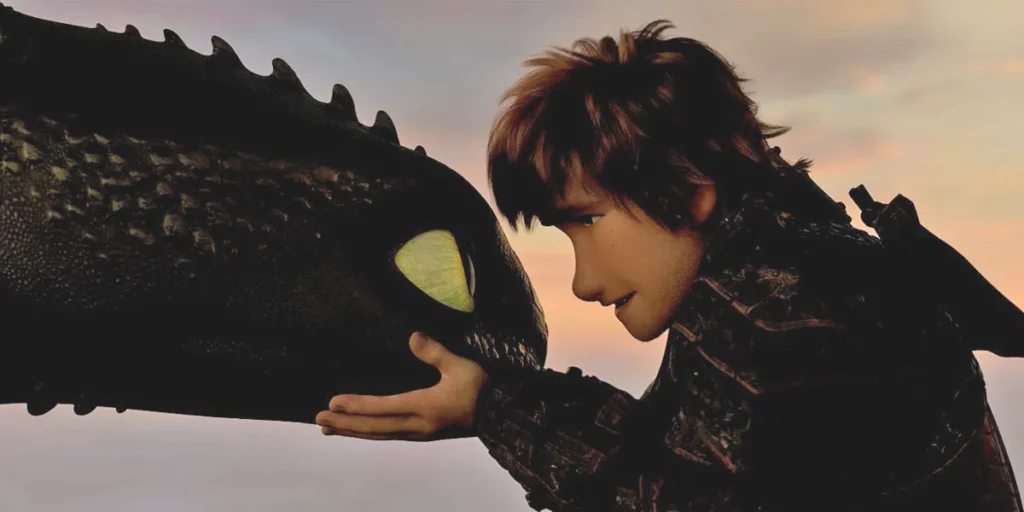How does the How to Train Your Dragon trilogy evolve with each entry, slowly transforming what each character wants and needs? Let’s find out in this retrospective!
DreamWorks Animation. A studio that I’m equal parts proud and ashamed to call a huge part of my childhood. I’m proud because it’s the same studio that made the How to Train Your Dragon trilogy, and I’m ashamed because they also made Shark Tale, a Will Smith movie that’s more of a slap in the face than his literal slap in the face. But let’s not worry about that, instead doing a retrospective on the former. The How to Train Your Dragon trilogy is one of the most acclaimed sets of films in the DreamWorks lineup, having charmed millions of children and adults alike with each installment and formed a cohesive, engaging overarching story about a boy and his … well, dragon. But let’s be honest; it’s really a dog in a dragon’s body. And I’m okay with that.
I didn’t grow up with the How to Train Your Dragon trilogy, since the first movie came out when I was a teen uninterested in family-oriented animation. When I finally did catch up with the whole series several years ago, however, I was quickly won over. Throughout all three installments, this is a film series filled to the brim with an infectiously charming emotional core, naturally building stakes and scope, jaw-dropping animation, and an engaging story that sees characters come of age in more ways than you may expect. How does that story evolve with each entry, and how does it slowly transform your understanding of what each character wants and needs? Let’s find out by looking over all three films in chronological order!
HOW TO TRAIN YOUR DRAGON
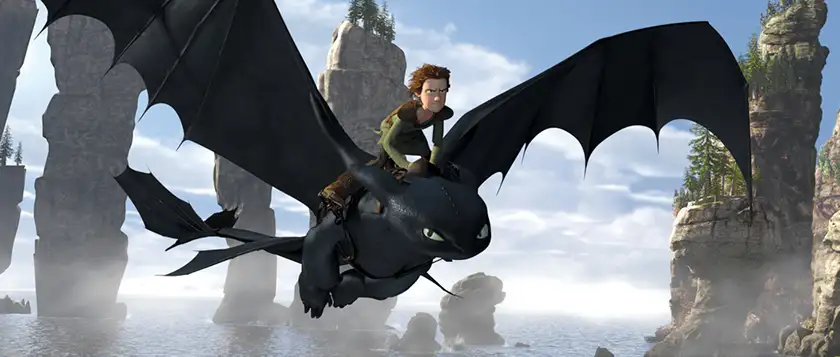
The first How to Train Your Dragon came out in 2010, wielding a relatively simple, even clichéd premise … but a very well-executed one. Jay Baruchel (BlackBerry) plays Hiccup Horrendous Haddock III, an awkward boy in the Viking village of Berk who somehow doesn’t crack the top three worst character names in this series. He’s determined to prove himself by taking down and killing a dragon. But when he finally catches one, a Night Fury, he instead befriends it, even naming him Toothless for his retractable teeth. Though the two form a solid bond, the village’s disdain for dragons ultimately puts him at odds with his father, Chief Stoick the Vast (Gerard Butler, Plane).
A lot of this first installment relies on tropes you’ve seen done over and over, especially in animation. You’ve got the awkward geek trying to prove himself, a prejudice against something people don’t understand, a big secret that alienates the protagonist once it’s revealed, a parental figure who won’t listen to his child, and of course the hero rising up to save the day and win everyone back over. Not much is done to mix up the formula, which unfortunately makes this easily the most uninteresting story of the trilogy. None of these clichés are painful to get through or anything, but they more often than not just feel like gateways we have to hit to get to the good stuff.
Thankfully, that good stuff is well worth it, and the crowning achievement is the growing friendship between Hiccup and Toothless. The perception each of them has towards the other is instantly conveyed perfectly, as is the way that perception gradually changes. A lot of it is done solely through actions and expressions, and it’s paced well enough that you feel the time and commitment it takes to truly befriend this wild animal. (As opposed to the dragons Hiccup later tames with the Jurassic World approach of just holding your hand out and nothing more.)
Toothless is the precious everything of the trilogy, and you’re objectively dead inside if you don’t like him. The animation of his every movement is scarily spot-on, feral and wild while blending in more “human” traits so organically. For a CG animated film that’s 14 years old, How to Train Your Dragon still holds up nicely. The textures are a little iffy at points, but there’s an incredible sense of weight, gravity, and speed to the movements of every character and creature, especially during the flying sequences. And need I even mention the score? John Powell is one of the most overlooked composers in film, and his majestic, enchanting, powerfully rich main themes are guaranteed to hit you in the feels every time they show up.
I also like how Hiccup’s motivations are rather selfish at first. He wants to kill a dragon so that he can win the respect of his father, his crush Astrid Hofferson (America Ferrera, Barbie), and the rest of Berk, trying to play into the hypermasculine culture as opposed to embracing his true nature. You can tell he doesn’t even really have any real animosity towards the dragons themselves; he just cares about what killing them will do for him. The lessons at the end are also meant for both sides of the conflict, as Hiccup learns what it is to truly stand up for what he believes in while everyone else learns to accept change and let go of their most toxic Viking ways.
The climax falls shorter than everything else, unfortunately. It’s not bad, but it all hinges around a threat that doesn’t really feel needed and even somewhat contradicts the film’s other messages. “Dragons aren’t monsters!” the movie says … oh, except this one specific dragon who makes them all evil and stuff. The action is well handled and there’s a fair bit of intensity, but I could’ve used a more interesting threat for everyone to go up against. Especially since the side characters aren’t very likeable outside of Hiccup’s mentor, Gobber the Belch (Craig Ferguson) … I told you this series had terrible names, didn’t I?
Overall, How to Train Your Dragon is a good movie with a lot of great moving parts, most of which revolve around the titular dragon. Of all the films in the trilogy, this is the one I can see myself putting on the least often, but it also contains many sequences that rank right up there with the best parts of the sequels. It takes what could have been the most generic story ever and, through tons of love and dedication, turns it into an enjoyable and moving experience … as well as setting the stage for even better experiences to come.
HOW TO TRAIN YOUR DRAGON 2
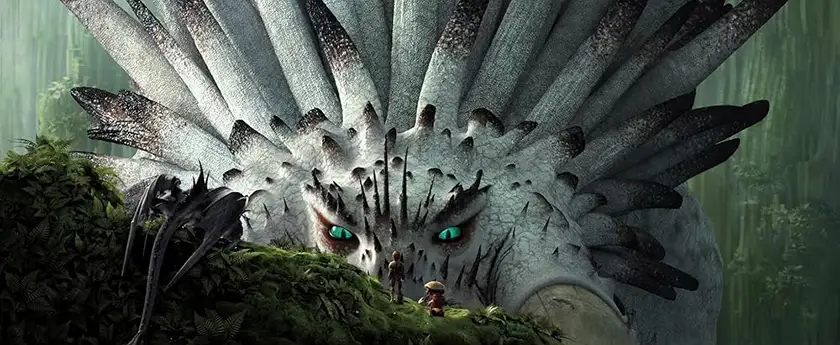
In 2014, four years after the original movie, How to Train Your Dragon 2 brought audiences back to Berk to continue the story. And, for me, this is where the series starts to really pick up. We begin five years after the first movie, seeing Berk is now a home to dragons living peacefully with humans. But when Hiccup and his girlfriend Astrid come across a gang of dragon trappers, they discover a plot by warlord Drago Bludvist (Djimon Hounsou, of A Quiet Place: Day One) to build and lead a dragon army. As the ensuing conflict builds, Hiccup and Stoick discover Hiccup’s mother, Valka (Cate Blanchett) is still alive and could lend her own dragon horde to the fight.
One of the biggest notable differences between this movie and the first one is the size of everything going on. Like many of the best sequels, How to Train Your Dragon 2 expands its predefined world in so many ways that it’s almost overwhelming. There are new characters, new realms, and more intertwining conflicts and strategies that push the characters farther than ever before. Dean DeBlois is the sole director this time (having co-directed the first film with Chris Sanders), but it’s clear he knows how to capture the massive, legendary scope that comes with these larger-than-life additions. The animation is also staggeringly improved, still as vibrant as before but with much better textures and smoother expressions.
Something Dubois also nails here is the pacing. The first movie never felt rushed, but a lot more of this one plays out slowly, in near silence, letting every incredible discovery feel that much more important and even tense. This applies to sequences of wonder and dread, both of which are also considerably upped. Big props to Roger Deakins, the visual supervisor for the film whose touch is very apparent. Of all three films, this one feels the most consistently epic in both its story and visuals.
You can tell right away that Hiccup is much more grown into himself as a character. Gone is the awkward child from before, replaced by a more mature and capable young adult who’s still learning. He’s on the cusp of becoming chief now, while facing new threats that force him to make the tough choices that come with that looming responsibility. He initially believes the same peaceful tactics that won his tribe over will work again with Drago, only to be given a painful wake-up call that challenges whether that kind nature can even work at all anymore.
Drago is my favorite villain of the trilogy for two reasons. One, Djimon Hounsou needs to be in as many things as possible until Hollywood finally gives him the juicy lead role he deserves. And two, he’s the exact opposite of Hiccup: physically imposing, toxic, driven by hatred and a cold hunger for power, and more of a feral beast than any dragon in the series. The clash of his forced dominance over dragons against Hiccup’s strong-willed respect makes for a good dichotomy that’s satisfying to see play out, even giving Toothless some growth as he’s caught in the middle of this war.
None of this is even mentioning the discovery of Hiccup’s mom, which itself is an endearing way of fleshing out the family and bringing even more perspective to Hiccup’s choices. There’s a lot going on in How to Train Your Dragon 2 … so much so that the story can get a little jumbled. You’re never lost on what’s going on, but there are so many moving parts that it’s easy to either temporarily forget or not get as invested as you want to be, since the momentum of any given emotional beat can be thrown off by a cut to something almost entirely different.
How to Train Your Dragon 2 is strange, because it’s easily the most consistently good entry in the trilogy across the board, and it has so many outstanding sequences … I just don’t consider it an outstanding film. Maybe I wanted some more adult grit to match the more epic story, or maybe each of the many subplots needed more time to be fleshed out … time that could’ve been taken from Hiccup’s friends not named Astrid, because they contribute absolutely nothing and are annoying more often than not. This is a film where the whole isn’t quite as great as the sum of its parts … but it’s still pretty great. How to Train Your Dragon 2 does everything a sequel should do by upping the ante, making its world feel bigger than ever, and continuing the characters’ journeys in meaningful ways.
HOW TO TRAIN YOUR DRAGON: THE HIDDEN WORLD
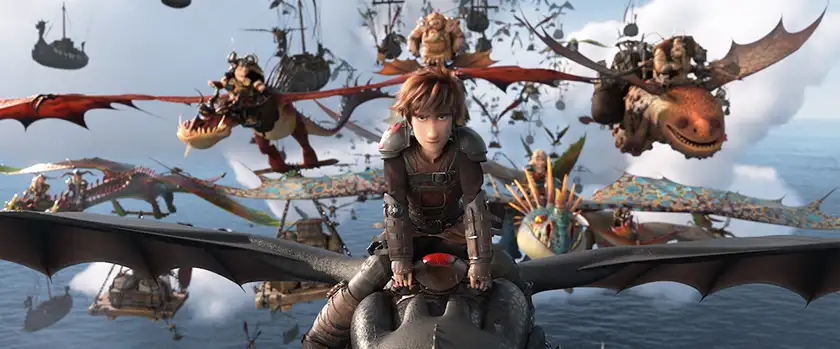
And now we come to the conclusion … as well as the only one of these movies that I actually saw on the big screen! How to Train Your Dragon: The Hidden World is home to some of the best, most gut-wrenching, and most spiritually profound moments in the entire trilogy … as well as some of the worst and most irritating. One year after the events of 2, we return to a Berk that’s taken in so many dragons that it’s getting overcrowded. Even worse, the village has been regularly targeted by dragon hunters, the newest of which is Grimmel the Grisly (F. Murray Abraham, of The Grand Budapest Hotel). Hiccup and the rest of Berk thus seek to relocate to the fabled Hidden World, where they can live hidden away with their dragons. Along the way, Toothless meets and becomes smitten with a white female Night Fury (a Light Fury), complicating his relationship with Hiccup.
The first two How to Train Your Dragon movies show Hiccup and Toothless growing and maturing through a bond with each other that gets stronger over time, and the grander link between humans and dragons signifies the growth of both and what either is capable of together … But The Hidden World is an answer to the question: what are they on their own now? Can they survive on their own now? Should they? At the end of the day, these are still two different species that, though now amicable, still have different needs, all of which come to an unexpected head in this final chapter.
Throughout the film, you can feel the reconciliation of this reality coming, this notion that what’s been built was never meant to last forever. The animal that Toothless is gets explored to new degrees here, particularly through his connection with the Light Fury. You’d be forgiven if you thought she would be a gimmick at a first glance – just a gender-swapped Toothless for him to fall in love with – but she plays a pivotal, even profound role through the impact their romance has on everyone else. Their scenes are adorable and once again show how good this series is at getting across emotion and meaning purely through its animation.
On that note, it is staggering how far the trilogy’s visuals have come in nine years. The landscapes, everyone’s perfected movements, the sheer tangibility of every drop of fog, sunlight, and darkness … This is one of the most stunning-looking movies ever, period. The actual discovery of the Hidden World is nothing short of mythical, so breathtaking in its buildup, design, and rendering that it should be a textbook example of why animation is so impactful as a medium. Rounding everything out is not just John Powell’s best score of the trilogy, but one of my favorite film scores of all time. It’s operatic, haunting, tender, bombastic … I’m just spouting out adjectives at this point, so go and listen to it!
But here are some different adjectives: obnoxious, pointless, and desperate, all of which I can use to describe any scenes dedicated to the human side characters. Hiccup’s friends, played by Jonah Hill, Christopher Mintz-Plasse, Kristen Wiig, and Justin Rupple, have been dead weight since the first movie and get more annoying with each sequel. Their scenes aren’t interesting, they don’t tie into the story well if at all, and in this one, they even cause other, much better characters like Valka to go to utter waste. The Hidden World has noticeably more comedy than the other films, and when that comedy is largely on the backs of these clowns, that’s a problem. Rupple’s character is more insufferable here than when he was voiced by T.J. Miller in the other movies … How is that physically possible?!
Grimmel as a villain is just fine. His next-level cunningness makes him a formidable threat whose pursuit you always feel, but as a character, he has too many parallels with Drago without the same physical prowess. The final battle with him is serviceable, but there’s not much in the way of pathos and it’s overall forgettable. What isn’t forgettable is what comes after: a bittersweet, emotional onslaught and an ending that turns me into a blithering mess every time I see it. No joke, I was steeling myself up when I started my rewatch of The Hidden World because I knew it was going to end with me like this. Yeah, I ugly cried at the silly dragon movie, and you should too, dammit.
That ending is enough to put The Hidden World on par with the second movie for me. How to Train Your Dragon 2 is a more well-rounded experience, but this final chapter has such incredible highs and is such an unexpectedly subversive way to end the story that I have to rank it as my favorite of the trilogy by a fraction of a hair. It sees the main characters, animation, music, and visual storytelling at their absolute best, easily overpowering the downgrade in the side characters, humor, and (to a lesser degree) villain. It’s not where I thought the story would go, but it feels so right when all is said and done.
WHAT IS THE HOW TO TRAIN YOUR DRAGON TRILOGY ABOUT?
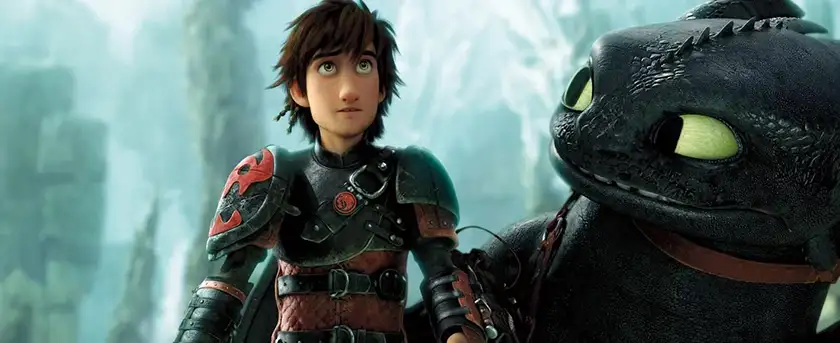
Clearly, I have a lot of fondness for the How to Train Your Dragon trilogy. I don’t see any of the movies as masterpieces, but each one has irresistible charm, heartfelt storytelling, increasingly beautiful visuals, and one piece of an overall grand, cohesive narrative. At its core is the relationship between Hiccup and Toothless, a tale of two unlikely friends who bring out the best in each other and everyone else. But the consequences and escalation that come from such major change are also addressed, ultimately leading to the end of their journey in some ways but an irreversible impact that will remain with these characters forever.
DreamWorks Animation is the most fascinating animation studio to me. For every piece of pandering, childish fluff that I have no interest in seeing, they’ll come out with something fun, imaginative, and at times even mature that I can recommend to anyone of any age with an open mind. Though flawed in some areas, the How to Train Your Dragon trilogy has so many of those great qualities, enough to have won me over despite it not being part of my childhood in any capacity. Despite them dating as far back as 14 years, all three films soar high enough to hold up even today.
The How to Train Your Dragon Trilogy is now available to watch on digital and on demand. Read our retrospectives on the Before Trilogy and the Matrix movies!

